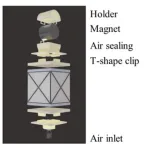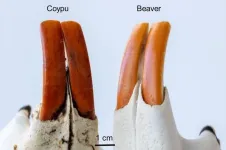(Press-News.org) In patients undergoing colonoscopy to screen for colorectal cancer, deeper sedation using the anesthetic drug propofol may improve detection of "serrated" polyps — a type of precancerous lesion that can be difficult to detect, reports a study in the Online First edition of Anesthesiology, the peer-reviewed journal of the American Society of Anesthesiologists (ASA).
"Our study provides the first evidence that monitored anesthesia care with propofol might increase detection of serrated polyps, which are more likely to be missed than adenomatous polyps during colonoscopy," said lead author Aurora N. Quaye, M.D., member of the Acute Pain and Regional Anesthesia Service at Maine Medical Center, Portland. "Propofol-based anesthesia may contribute to a more effective screening process for colorectal cancer, especially in patients with risk factors for serrated polyps."
Nearly all colorectal cancers start off as small growths called polyps. Identifying and removing polyps during colonoscopy screening can prevent them from developing into cancer. Compared to a more common type of polyp called adenoma, serrated polyps may be harder to see, because they are often flatter and blend into the folds of the colon tissue.
Propofol is an alternative to moderate sedation — sometimes called "conscious" sedation — for colonoscopy. "Propofol results in deeper sedation, and also begins to work and wears off more quickly, compared to conscious sedation," Dr. Quaye explained. Research has shown that propofol-based anesthesia is more efficient and improves patient and provider satisfaction ratings. The new study is the first to assess whether propofol may be associated with improved detection of serrated polyps.
The analysis included detailed information on more than 54,000 completed colonoscopies drawn from the New Hampshire Colonoscopy Registry. The procedures were performed between 2015 and 2020; all patients were older than 50 years. Rates of polyp detection, including serrated polyps and adenomas, were compared for patients receiving moderate sedation versus propofol-based anesthesia.
The overall polyp detection rate was higher when colonoscopy was performed using propofol: 34%, compared to 24.5% with moderate sedation. The results were similar on analysis of a "restricted" sample of about 19,000 colonoscopies performed at facilities that did not predominantly use one form of sedation over the other: overall polyp detection rate was 30.3% with propofol versus 25.7% with moderate sedation.
After adjustment for other confounding factors among these 19,000 colonoscopies, propofol was still associated with a clinically and statistically significant 13% higher likelihood of serrated polyp detection, although other types of polyps did not demonstrate a difference in detection.
The conclusions are strengthened by the use of systematically collected clinical registry data, the researchers note. However, the study cannot provide any information on how propofol might improve detection of serrated polyps. "It may be that propofol increases patient comfort and relaxation, optimizing detection of polyps that are more difficult to see," said Dr. Quaye. "Additionally, propofol may cause smooth muscle relaxation in the colon, allowing more careful inspection and improved visualization."
The researchers emphasize the need for further studies to clarify the possible advantages of propofol for polyp detection. "The finding that propofol-based anesthesia might improve the detection of precancerous polyps may bring us closer to our goal of further optimizing the use of colonoscopy for the prevention and early detection of colorectal cancer," said Dr. Quaye.
The modest but significant reported association between propofol use and the detection of serrated polyps illustrates the "promise and peril" of studies using clinical registry data, according to an accompanying editorial by Douglas A. Colquhoun, MB, ChB, MSc, MPH, University of Michigan, Ann Arbor, and colleagues. While warning that the results must be interpreted with caution due to limitations in analyzing registry data, the editorial authors highlight the importance of preserving access to propofol and call for further, "rigorously conducted" studies focusing on the value of anesthesia care for patients undergoing colonoscopy.
ABOUT THE AMERICAN SOCIETY OF ANESTHESIOLOGISTS
Founded in 1905, the American Society of Anesthesiologists (ASA) is an educational, research and scientific society with nearly 58,000 members organized to advance the medical practice of anesthesiology and secure its future. ASA is committed to ensuring anesthesiologists evaluate and supervise the medical care of all patients before, during, and after surgery. ASA members also lead the care of critically ill patients in intensive care units, as well as treat pain in both acute and chronic settings.
For more information on the field of anesthesiology, visit the American Society of Anesthesiologists online at asahq.org. To learn more about how anesthesiologists help ensure patient safety, visit asahq.org/madeforthismoment. Like ASA on Facebook and follow ASALifeline on X/Twitter.
Follow Anesthesiology on X/Twitter at @_Anesthesiology, on Facebook, or on Instagram.
END
Deeper sedation may help find difficult-to-detect polyps during colonoscopy
Propofol anesthesia may aid in preventing colorectal cancers due to 'serrated' polyps
2024-04-17
ELSE PRESS RELEASES FROM THIS DATE:
Virtual-dimension increase of EMG signals for prosthetic hands gesture recognition
2024-04-17
The electromyographic(EMG) signal is the bioelectrical current generated during muscle contraction. It can be transmitted as an input signal to an intelligent bionic prosthetic hand to control hand movements. By increasing the number of signal acquisition channels, richer information about the intention of the action can be captured, thus improving the success rate of the recognition of the intention of the action. However, it is not better to have more acquisition channels. As the number of channels increases, the hardware system becomes more complex, and the effect of improving the accuracy of gesture recognition gradually ...
Magneto-pneumatic hybrid-driven soft actuator with bidirectional torsion
2024-04-17
The ability of the human wrist to rotate around the forearm axis in 2 directions is crucial for many daily activities. This rotation, limited to a range of approximately [-90°, 90°], restricts the wrist's capacity to execute complex operational tasks. For example, when we open or lock a door with a key, our wrist performs a large rotational movement. When we screw, the wrist needs to twist 180° several times. However, due to the limited rotation angle, the hand needs to leave the key or screwdriver several times to complete the entire work process. In order to realize large rotation ratio in a single actuator, a research team from Zhejiang ...
One million US dollars for mapping the “springs of the spinal fluid”
2024-04-17
A research team at DZNE has been awarded around one million US dollars for the development of an innovative, AI-based method to measure the “choroid plexus” three-dimensionally in human brain scans. These finely branched brain structures are the main sources of the “cerebrospinal fluid” and thus of great significance for the function of the brain and spinal cord. It is also assumed that they play a role in various neurological diseases, including Alzheimer’s. The research project is funded by the US National Institutes of Health (NIH).
The “cerebrospinal fluid” (CSF) is ...
Challenges in Greenland marine research and insights and priorities for development of East Greenland marine and coastal environments
2024-04-17
This report presents gained knowledge identified at two events during the Greenland Science Week on the 7th of November 2023 in Nuuk, Greenland:
The 1st Biennial Greenland Marine Research Seminar and
The workshop on Status and Development for East Greenland Waters
Both events had a forward-looking focus, to gain insight and knowledge from stakeholders and other parties, to be implemented in future research. The marine research seminar also served as a follow-up on earlier ECOTIP and Face-It stakeholder involvement in Greenland and was an opportunity to share project results and recommendations ...
Copper beads in pig feed reshape swine gut microbiome
2024-04-17
Highlights:
In lab experiments, copper shows antimicrobial properties, including against pathogens like Salmonella.
Copper beads in animal feeds may improve gut health in pigs.
A new bead design effectively delivers copper to the lower intestine.
New findings show copper beads influence the microbial makeup in a pig’s gut, but more work is needed to optimize the benefits.
Washington, D.C. — April 17, 2024 — Copper is a natural antimicrobial material that, when added to pig feed, may promote the growth and ...
FAU Engineering selected by NASA for University Nanosatellite Program
2024-04-17
Florida Atlantic University’s College of Engineering and Computer Science is among eight university teams in the United States selected to work with NASA and the U.S. military to foster innovation and expertise in the small satellite sector.
NASA’s CubeSat Launch Initiative (CSLI) is partnering with the U.S. Air Force and U.S. Space Force for the 2024 Mission Concept Program. A CubeSat is among a class of research spacecraft called nanosatellites about the size of a 4-inch cube and typically weighing less than 5 pounds.
Running from May through August, the University Nanosatellite ...
Nursing resources affect hospital patient experience ratings
2024-04-17
Waltham — April 10, 2024 — The nursing work environment, nurse education, and staffing levels are independent factors affecting hospital scores on a key measure of patient-centered care – with significant implications for reimbursements, reports a study in Medical Care. The journal is published in the Lippincott portfolio by Wolters Kluwer.
"Our results provide evidence-based guidance about which modifiable aspects of hospital nursing are likely to improve patient experience ratings," said Kathleen E. Fitzpatrick Rosenbaum, PhD, RN, CCRN, of Yale University.
How do nursing factors affect HCAHPS ...
Tracking a protein’s fleeting shape changes
2024-04-17
Researchers at Weill Cornell Medicine have developed a powerful, new technique to generate “movies” of changing protein structures and speeds of up to 50 frames per second.
Senior author, Dr. Simon Scheuring, the Distinguished Professor of Anesthesiology Research at Weill Cornell Medicine and colleagues developed the new approach to gain a better understanding of how biological molecules change structurally over time. Although investigators in this field routinely image static proteins and other molecules finely ...
Study finds iron-rich enamel protects, but doesn’t color, rodents’ orange-brown incisors
2024-04-17
Chattering squirrels, charming coypus, and tail-slapping beavers — along with some other rodents — have orange-brown front teeth. Researchers have published high-resolution images of rodent incisors in ACS Nano, providing an atomic-level view of the teeth’s ingenious enamel and its coating. They discovered tiny pockets of iron-rich materials in the enamel that form a protective shield for the teeth but, importantly, don’t contribute to the orange-brown hue — new insights that could improve human dentistry.
Human and animal teeth are coated in a ...
Continuing efforts are addressing health disparities among Hispanic Latino people in U.S.
2024-04-17
DALLAS, April 17, 2024 — Language barriers, longstanding structural racism barriers, underrepresentation within the ranks of health care professionals and higher than average rates of poor health risk factors are among the alarming trends that continue to impede quality health care outcomes for Hispanic Latino people living in the United States. The American Heart Association, celebrating 100 years of lifesaving service as the world’s leading nonprofit organization focused on heart and brain health for all, is making strides ...
LAST 30 PRESS RELEASES:
Making lighter work of calculating fluid and heat flow
Normalizing blood sugar can halve heart attack risk
Lowering blood sugar cuts heart attack risk in people with prediabetes
Study links genetic variants to risk of blinding eye disease in premature infants
Non-opioid ‘pain sponge’ therapy halts cartilage degeneration and relieves chronic pain
AI can pick up cultural values by mimicking how kids learn
China’s ecological redlines offer fast track to 30 x 30 global conservation goal
Invisible indoor threats: emerging household contaminants and their growing risks to human health
Adding antibody treatment to chemo boosts outcomes for children with rare cancer
Germline pathogenic variants among women without a history of breast cancer
Tanning beds triple melanoma risk, potentially causing broad DNA damage
Unique bond identified as key to viral infection speed
Indoor tanning makes youthful skin much older on a genetic level
Mouse model sheds new light on the causes and potential solutions to human GI problems linked to muscular dystrophy
The Journal of Nuclear Medicine ahead-of-print tip sheet: December 12, 2025
Smarter tools for peering into the microscopic world
Applications open for funding to conduct research in the Kinsey Institute archives
Global measure underestimates the severity of food insecurity
Child survivors of critical illness are missing out on timely follow up care
Risk-based vs annual breast cancer screening / the WISDOM randomized clinical trial
University of Toronto launches Electric Vehicle Innovation Ontario to accelerate advanced EV technologies and build Canada’s innovation advantage
Early relapse predicts poor outcomes in aggressive blood cancer
American College of Lifestyle Medicine applauds two CMS models aligned with lifestyle medicine practice and reimbursement
Clinical trial finds cannabis use not a barrier to quitting nicotine vaping
Supplemental nutrition assistance program policies and food insecurity
Switching immune cells to “night mode” could limit damage after a heart attack, study suggests
URI-based Global RIghts Project report spotlights continued troubling trends in worldwide inhumane treatment
Neutrophils are less aggressive at night, explaining why nighttime heart attacks cause less damage than daytime events
Menopausal hormone therapy may not pose breast cancer risk for women with BRCA mutations
Mobile health tool may improve quality of life for adolescent and young adult breast cancer survivors
[Press-News.org] Deeper sedation may help find difficult-to-detect polyps during colonoscopyPropofol anesthesia may aid in preventing colorectal cancers due to 'serrated' polyps


